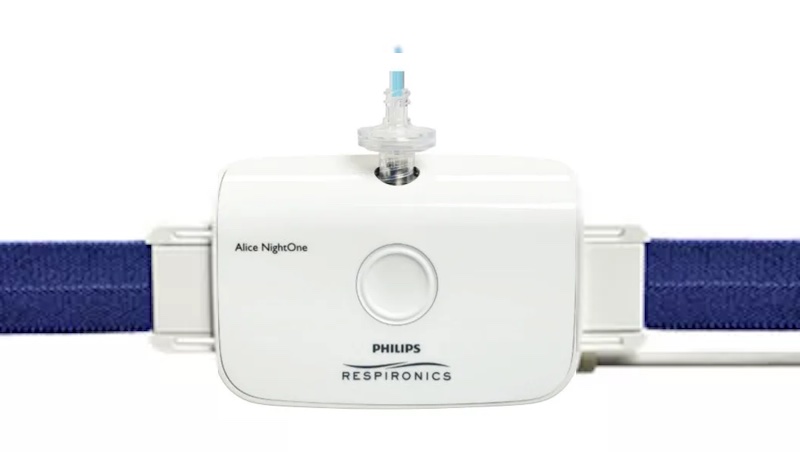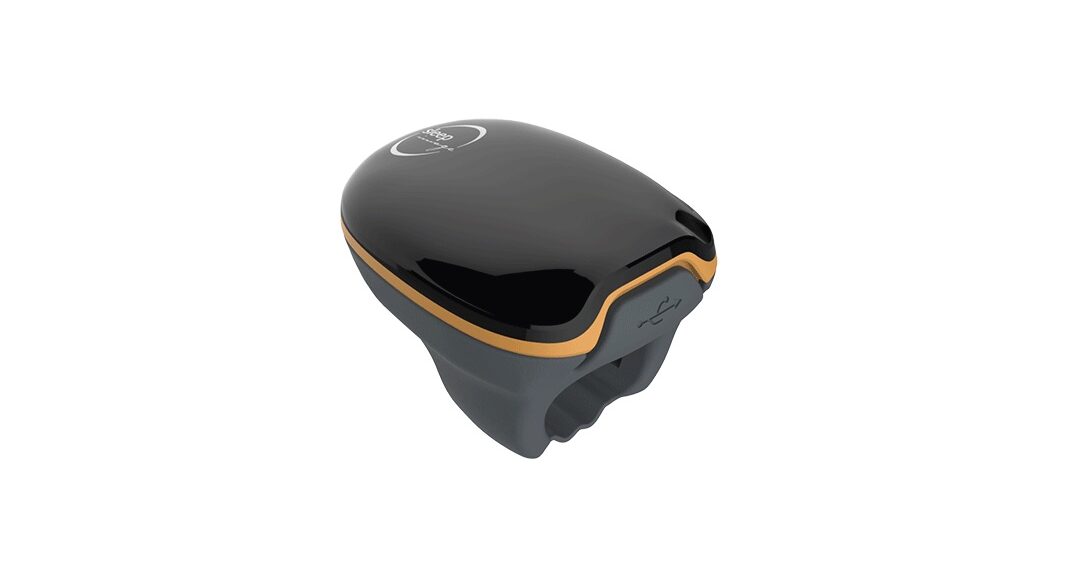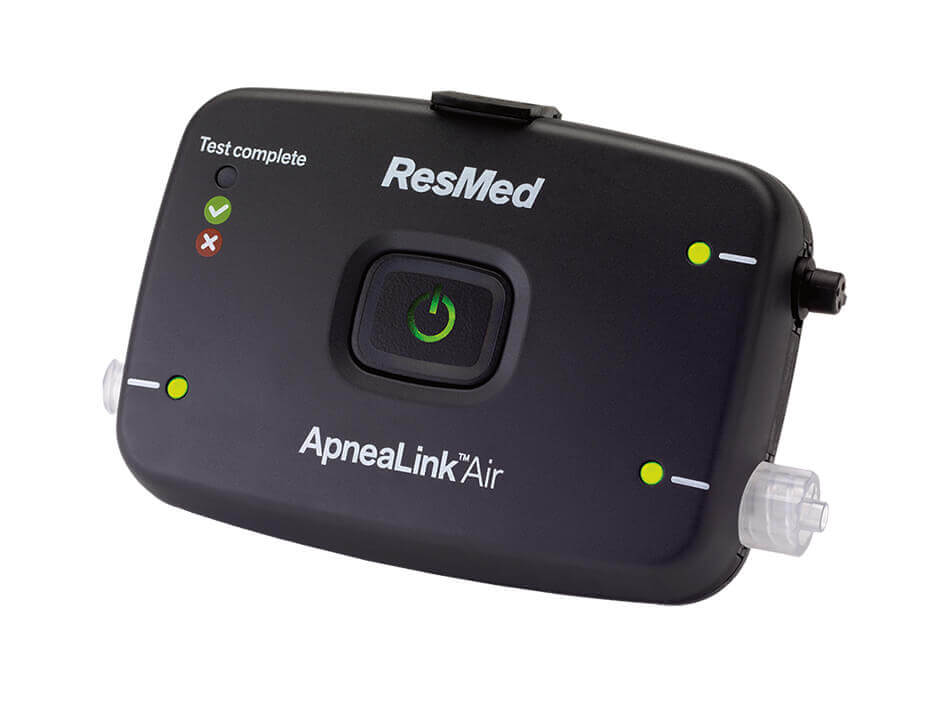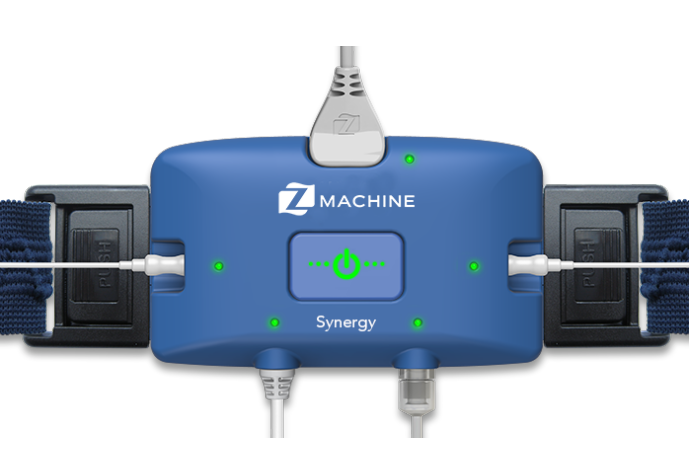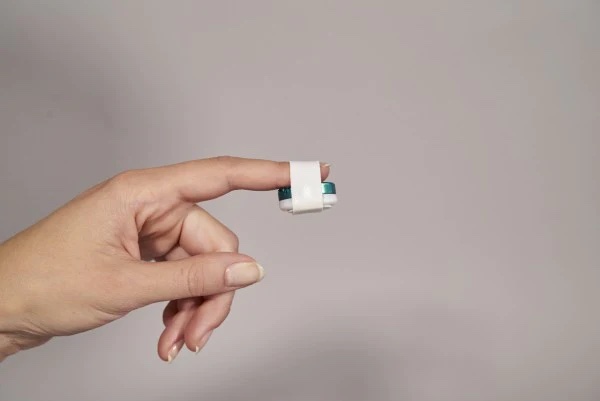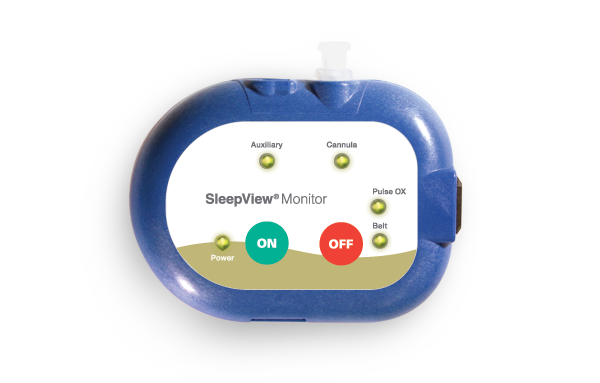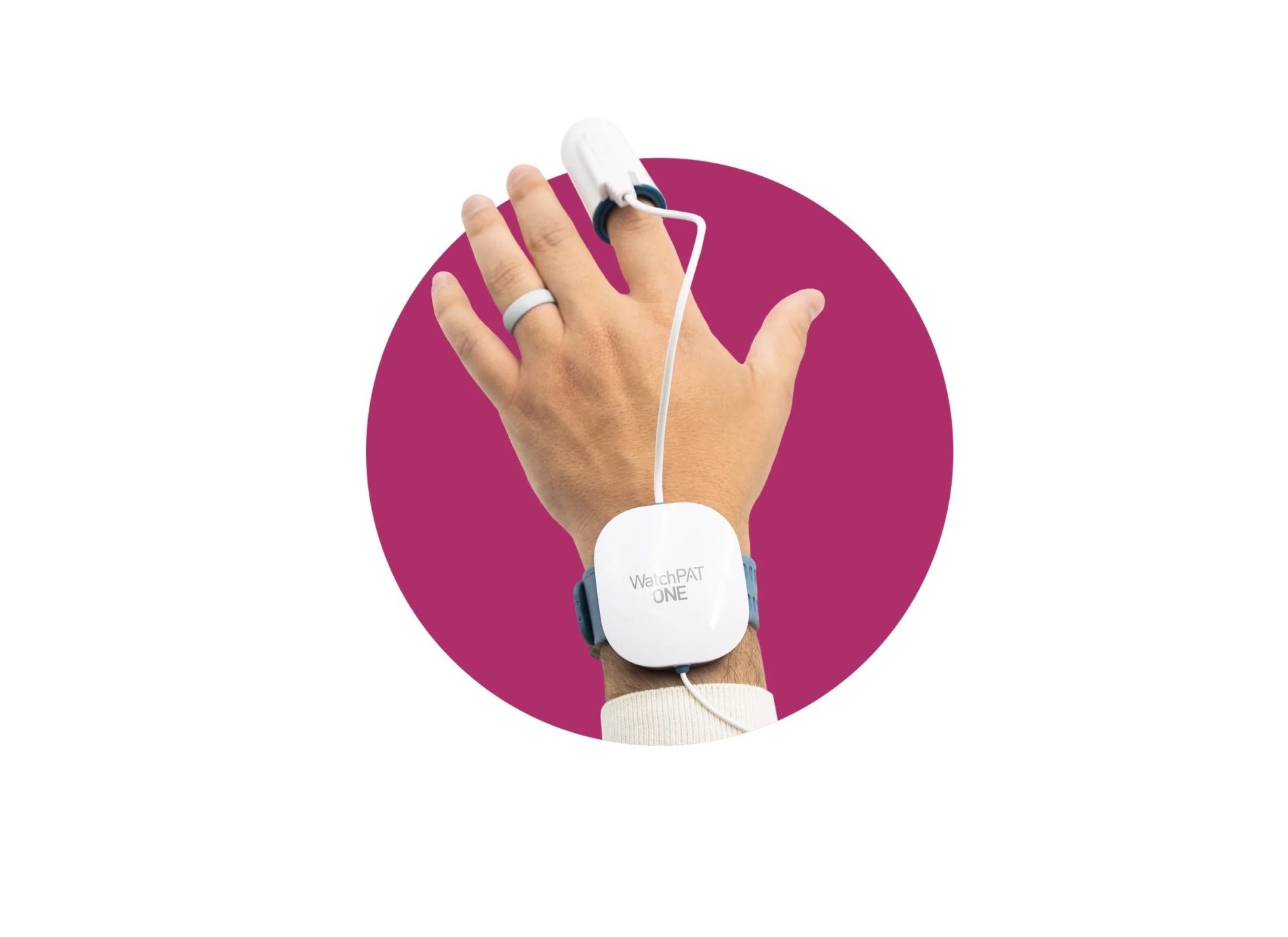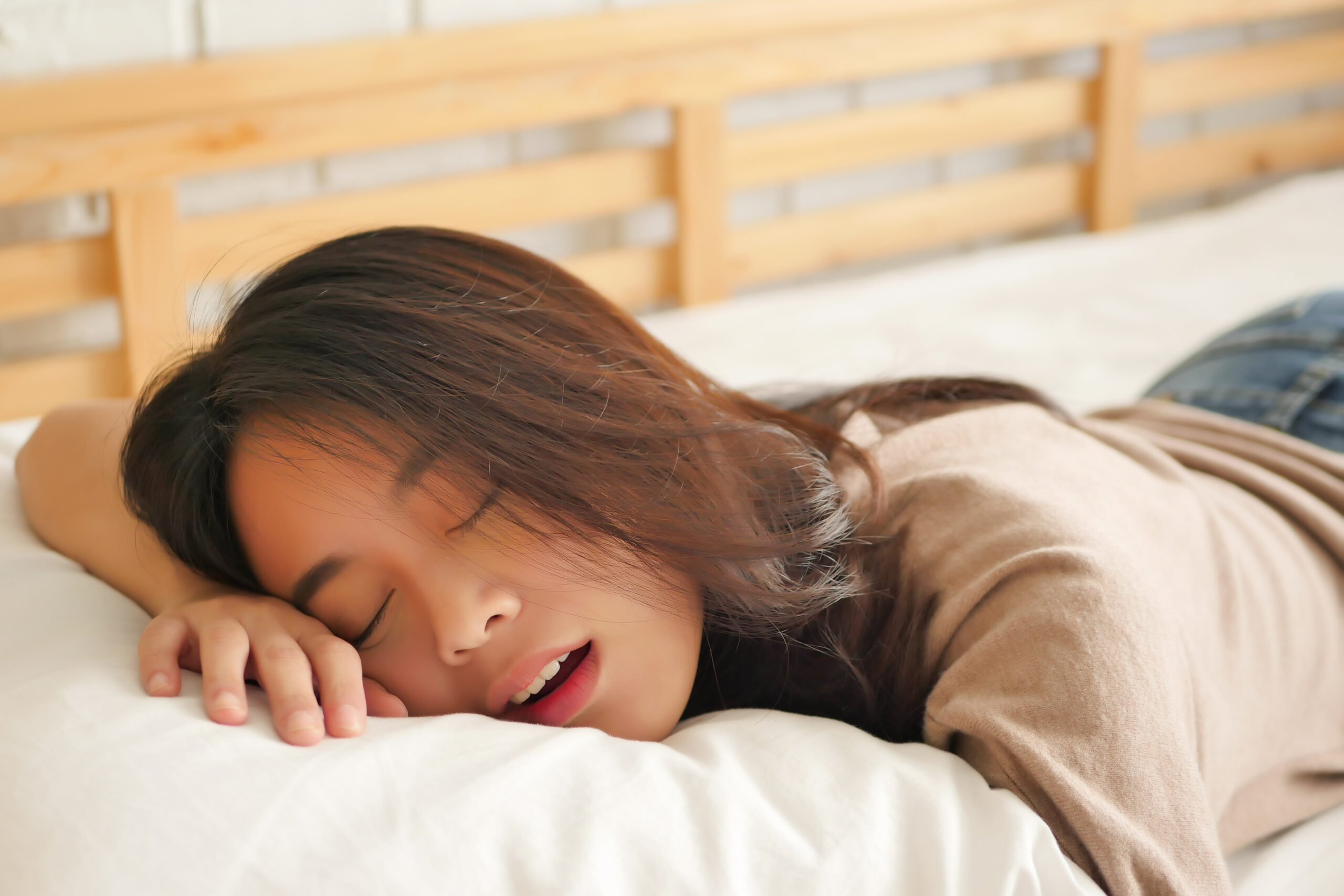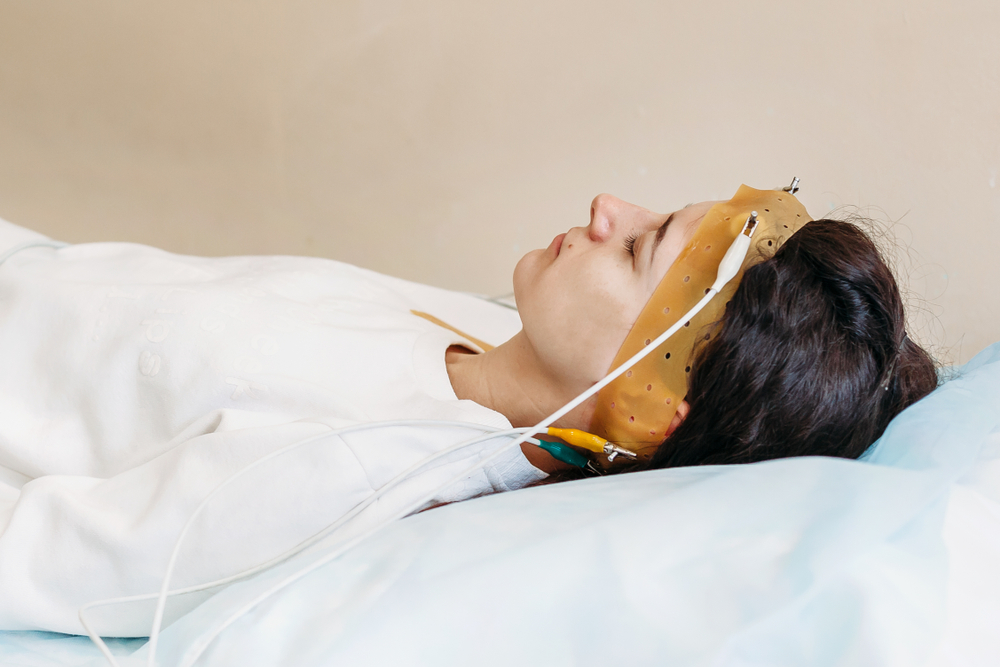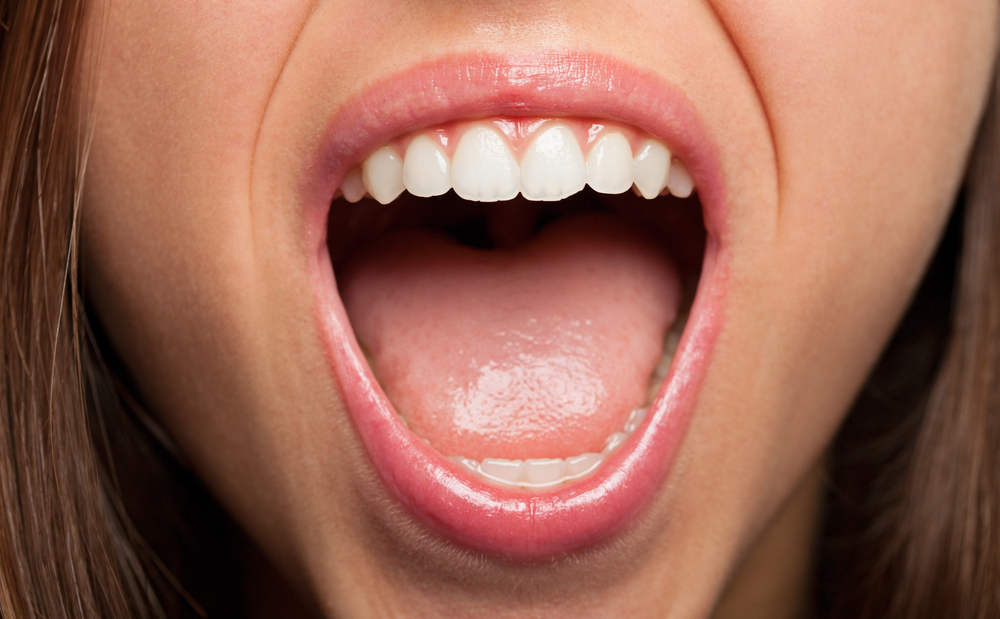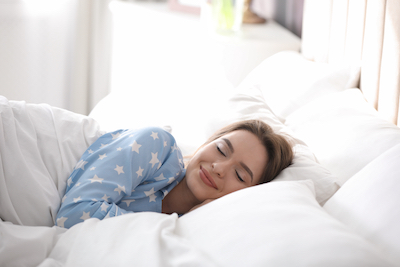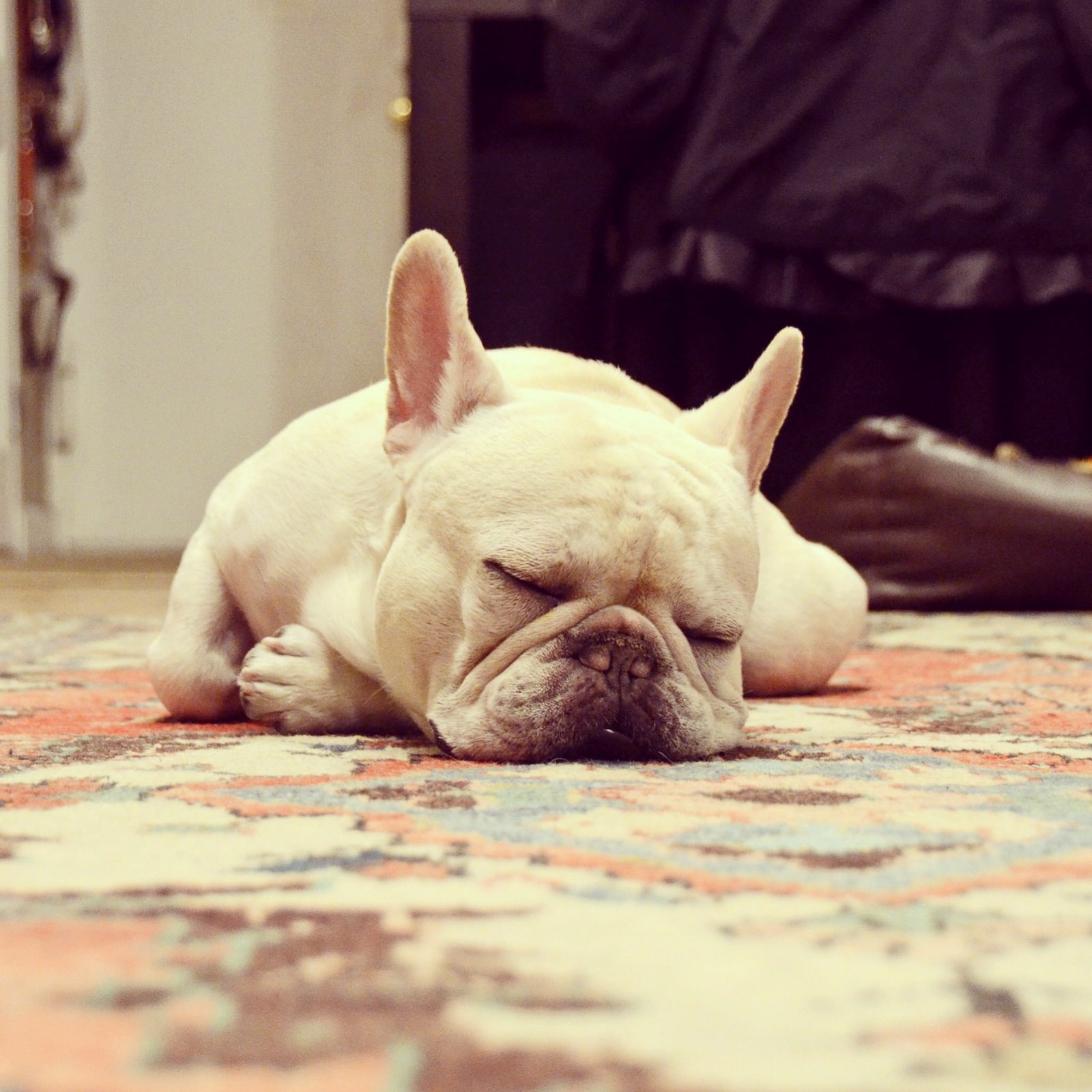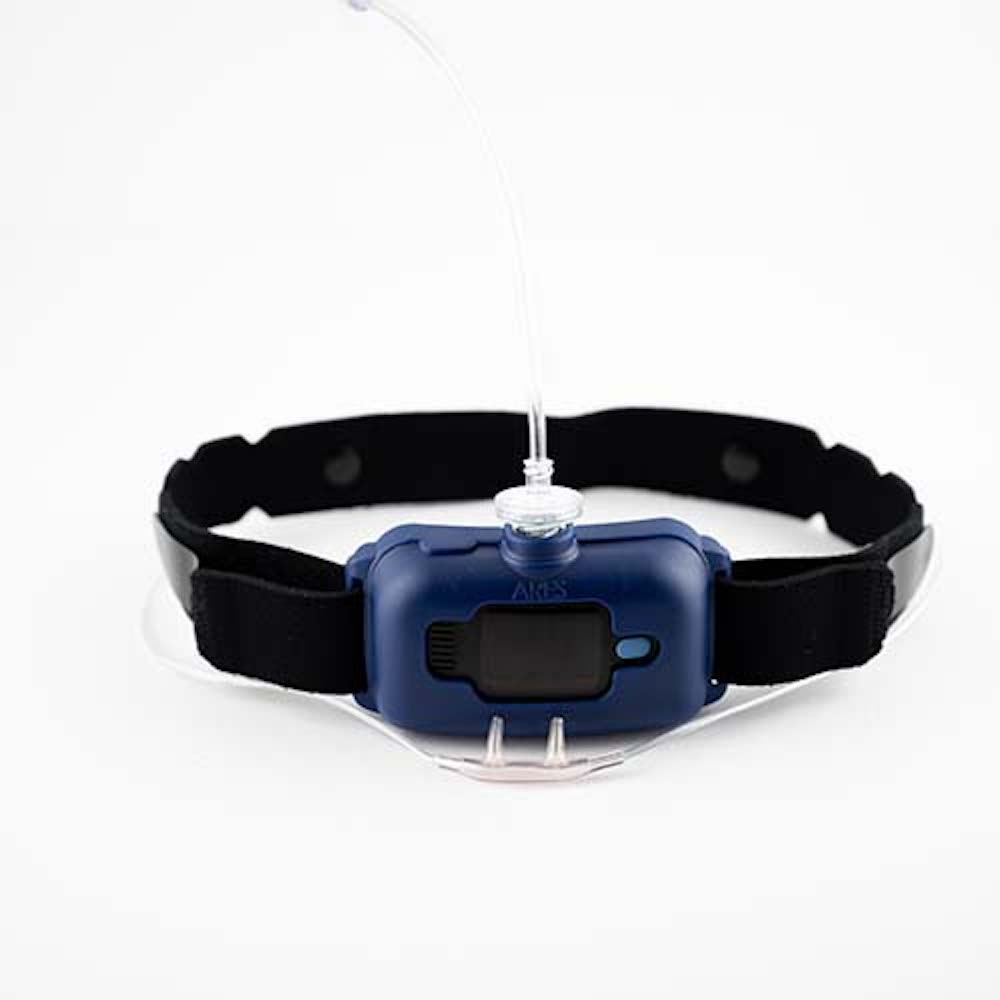Look & Feel
The Alice NightOne allows individuals to complete a sleep apnea test at home. Its simple design and automatic step-by-step startup process make it easy to use.
The device consists of three components: an effort belt that straps across your chest; a pulse oximeter that attaches to your index finger; and a nasal cannula that’s inserted just inside your nostrils.
The effort belt houses the “brain” of the device that records data. The device automatically turns on when the effort belt is buckled, and illuminated sensors tell you if the components are connected correctly.
Ideal For
- Individuals who have difficulty sleeping in a clinical setting
- Those who want results fast
- People looking for an affordable sleep apnea test
Who should keep looking
- People who think they may have another condition in addition to sleep apnea
- Those whose insurance doesn’t cover an at-home test
- Individuals who want a technician to be available during the test
-
Price
$295
-
Dimensions
4.07” x 0.99” x 2.67”
-
Test Location
Chest, nasal, & finger
-
Weight
84 grams
The Philips Alice NightOne is a wearable device that lets you test for sleep apnea in the comfort of your home. It’s designed to be lightweight and nonintrusive while gathering accurate sleep data. The device communicates if the information collected was sufficient or if more testing is needed.
We’ll take a closer look at the features of the Philips Alice NightOne, including how to use the device and what metrics it tracks. We’ll also compare the at-home testing process to a lab-based sleep study and discuss who might be a good candidate for the Alice NightOne.
Use this SleepApnea.org link for the most current discount on Philips products
Shop NowWhat Is Obstructive Sleep Apnea (OSA)?
Obstructive sleep apnea (OSA) is a disorder where an individual’s breathing pauses during sleep due to a narrowed or blocked airway. Several factors increase a person’s chances of developing OSA, including obesity, alcohol use, frequent nasal congestion, and enlarged tonsils.
The apnea-hypopnea index (AHI) is a commonly used diagnostic tool for measuring OSA severity. It’s calculated during a sleep study by dividing the total number of episodes of shallow or halted breathing by the total number of hours the person was asleep.
| Sleep Apnea Severity | AHI Score |
|---|---|
| Mild OSA | 5-15 |
| Moderate OSA | 15-30 |
| Severe OSA | 30 or higher |
Signs and Symptoms of Obstructive Sleep Apnea
Common signs that a person has obstructive sleep apnea include loud snoring, choking, and gasping for air during sleep. People with OSA often wake up unrefreshed, feel tired during the day, and are prone to forgetfulness and persistent headaches.
How the Alice NightOne Detects Symptoms of Sleep Apnea
The Alice NightOne uses an effort belt that rests against the chest, a pulse oximeter that attaches to the index finger, and a nasal cannula that’s inserted inside the nostrils to collect seven data points that collectively can help determine if a person has sleep apnea. These metrics include body positioning, pressure flow, amount of snoring, respiratory effort, blood oxygen level, pleth, and heart rate.
- Body positioning: The Alice NightOne device has a built-in sensor that can detect sleep position. This can help determine if a person primarily displays sleep apnea symptoms when sleeping on their back — the most common position for OSA events.
- Pressure flow: The nasal cannula has prongs that are inserted in each nostril to measure pressure changes during inhalation and exhalation. This can be a valuable tool in determining AHI score, which measures both pauses in breathing (apneas) and episodes of shallow breathing (hypopneas).
- Amount of snoring: While snoring rate on its own isn’t a reliable OSA indicator, this primary symptom of sleep apnea can aid in a diagnosis.
- Respiratory effort: The effort belt contains sensors that measure physical exertion and how difficult it is for a person to breathe. This can help differentiate between OSA and central sleep apnea (CSA). While OSA is characterized by difficulty breathing despite respiratory effort, CSA involves pauses in breathing due to the brain not sending signals to the muscles that facilitate respiration.
- Blood oxygen level: The pulse oximeter that connects to the index finger measures peripheral oxygen saturation (SpO2), an estimate of how much oxygen is present in a person’s blood. Pauses in breathing resulting from sleep apnea can lead to oxygen desaturation.
- Pleth: The pulse oximeter also tracks pleth, a waveform representation of changes in arterial blood volume. These measurements can be used to detect irregular blood flow patterns resulting from oxygen desaturation.
- Heart rate: The device takes your pulse throughout the night. Heart rate decreases during an apnea event, then increases when normal breathing resumes.
Types of Sleep Apnea This Device Detects
While the Alice NightOne is primarily designed for the detection of obstructive sleep apnea, the inclusion of an effort belt that straps across the chest also allows it to detect central sleep apnea. It’s also designed to detect apnea events that occur when a person sleeps on their back versus their side or stomach.
How the Alice NightOne Stacks Up Against Traditional Sleep Studies
While the Philips Alice NightOne can be an effective sleep analysis tool, a traditional lab-based sleep study is still the most accurate way to diagnose sleep apnea. One small study conducted in Vietnam indicated that the Alice NightOne tends to overestimate AHI score compared with a more comprehensive polysomnography device featuring more contact points.
However, overnight studies at a sleep clinic tend to be expensive. Additionally, some people have difficulty sleeping in that environment, making the Alice NightOne a viable choice for those who are unable or unwilling to participate in a lab-based study.
| Alice NightOne | In-Lab Sleep Study |
|---|---|
| Benefits:Can sleep in your own bedPotentially saves a visit to the doctor | Benefits:Provides more precise and detailed dataTechnician is available to troubleshoot any issues |
| Limitations:Some insurance companies may not cover at-home sleep apnea testingMay require further testing if results are inconclusive | Limitations:Might have to wait longer for an appointmentHigher cost |
Does the Alice NightOne Replace a CPAP Titration Study?
When the Alice NightOne test is complete, you’ll need to return the equipment to the provider it was rented from. Depending on the provider, you may receive a secure email with your results after a physician has reviewed the data. If the test results indicate that you have sleep apnea, the next step is to meet with a doctor either in person or via video call to discuss treatment options.
Depending on your diagnosis, a doctor may recommend treatment with a continuous positive airway pressure (CPAP) machine. This type of therapy delivers a fixed rate of pressurized air and generally requires an in-person CPAP titration to calibrate the appropriate pressure setting.
Some people may be a candidate for automatic positive airway pressure (APAP) therapy. Since an APAP machine automatically adjusts air pressure based on the user’s breathing patterns, it usually doesn’t require a titration study. However, an APAP machine might not be an appropriate option for people with more complex forms of sleep apnea or those with additional health conditions.
What You Need to Know About the Philips Alice NightOne
The Philips Alice NightOne is designed to detect and help diagnose sleep apnea. The main device is located in the center of an effort belt that straps across the chest. A nasal cannula that connects to the main unit features prongs that rest inside the nostrils. The device also features a pulse oximeter that attaches to the index finger.
The Alice NightOne contains built-in sensors that alert you if the device isn’t connected correctly. When the test is completed, the device’s display indicates if adequate data was collected.
What Comes With It
In addition to the main device and effort belt, pulse oximeter, and nasal cannula, the Alice NightOne comes with a user manual and quick start guide, as well as return packaging and instructions on how to ship the device back to the provider when the test is complete.
Components:
- Alice NightOne device
- Effort belt
- Pulse oximeter
- Nasal cannula
- User manual and quick start guide
- Return packaging
Technical Specifications
The device has several features designed for ease of use, including an auto-on function, illuminated sensor indicators, and a Good Study Indicator that tells you if you’ve collected a sufficient amount of high-quality data.
Price: $265
Features:
- Auto-on: Once the effort belt is buckled, the device turns on automatically.
- Smart Guide Setup: As you connect the device’s various components, sensor indicators change color from yellow to green once a good-quality signal is established. A sensor may turn back to yellow and flash if something isn’t working correctly once the initial setup is complete.
- Good Study Indicator: After the test is complete, a circular indicator divided into 25% increments provides an assessment of data quality.
How to Use This Device
The following instructions cover how to set up and operate the Alice NightOne. It’s important to note that the effort belt should be worn over a shirt, preferably something lightweight like a T-shirt.
- Step 1: Connect the belt. Place the effort belt on the center of your chest, wrap the strap around your back, and buckle it to the other side of the main Alice NightOne unit. The device will automatically power on once the belt is buckled. Initially, the belt indicator might flash yellow, which usually means the belt is too loose. Adjust the strap until the light is solid green.
- Step 2: Connect the nasal cannula. Once the belt is in the correct position, the nasal cannula light will flash yellow. Connect the cannula to the main device console before placing the prongs in your nostrils and gently wrapping the tubing around your ears and underneath your chin. Move the slider so the tubing isn’t too loose or tight. Use medical tape to secure the tubing to each cheek. The cannula icon will turn green once it’s properly connected.
- Step 3: Connect the pulse oximeter. After the cannula is in place, the pulse oximeter finger sensor symbol will flash yellow. Place the probe on the index finger of your nondominant hand, with the cable resting on the back of the hand. Secure the cable to your hand with the medical tape. The finger probe image will turn green once it’s secured.
- Step 4: Go to sleep. The device is successfully set up once all the lights are green. You can now go to bed. The lights will turn off one at a time over the next few minutes.
- Step 5: Remove the device. Upon waking in the morning, remove the various device components. The nasal cannula can be discarded. The device will automatically turn off after 30 minutes, or you can turn it off manually by holding the button in the center of the device for five seconds.
- Step 6: Check the study data. Wait at least one minute, then briefly press the center button to make the Good Study Indicator icon appear. If all four segments are green, the device collected good data. If one or more sections are yellow, it had difficulty recording data and you should contact the device provider to troubleshoot the issue.
- Step 7: Return the device. If the Alice NightOne has recorded sufficient data, all components except the disposable cannula should be promptly returned to the provider you rented it from.
Sleep Data Results and Diagnosis
After the device is returned, its data will be downloaded and analyzed. Some companies send you a secure email after the data has been reviewed by a physician.
If the results show that you have sleep apnea, you’ll need to review the results with a doctor before you can receive a prescription for a CPAP machine or another treatment option. This can be done in person with a doctor in your area or via a telemedicine video call.
Some online device providers, such as Singular Sleep, have doctors on staff who can review your results with you during a video call and provide a prescription for an APAP machine without the need for a subsequent titration study if you’re an appropriate candidate.
Use this SleepApnea.org link for the most current discount on Philips products
Shop NowWhat Do Customers Have to Say About the Alice NightOne?
Many comments from people who used the Alice NightOne have been positive. Users have noted how easy the device is to operate, and several commenters highlighted how they like that the sensors display a different color to indicate if the device is connected and functioning.
Common complaints include difficulty getting the effort belt to connect correctly without feeling too tight and trouble rectifying connectivity issues if a device component becomes detached during the night. The sensor icons flash yellow if a component is dislodged, but if you’re asleep there’s no way of seeing it.
| Availability | The Philips Alice NightOne is available for rent from authorized providers without a prescription, though test results need to be reviewed with a licensed physician before receiving a prescription for sleep apnea treatment. |
| Shipping | The device comes packaged in a durable container and contains instructions for returning the device once the study is completed. Some companies offer expedited shipping options. |
| Warranty | The Alice NightOne has a two-year manufacturer’s warranty. It’s not something most individuals need to worry about since they’re only borrowing the machine from a sleep study company. |
Medical Disclaimer: This content is for informational purposes and does not constitute medical advice. Please consult a health care provider prior to starting a new treatment or making changes to your treatment plan.
Still have questions?
Sleep apnea products can be confusing. If you need individualized assistance, send us an email at [email protected] with your questions and we'll help find the best fit for you.

